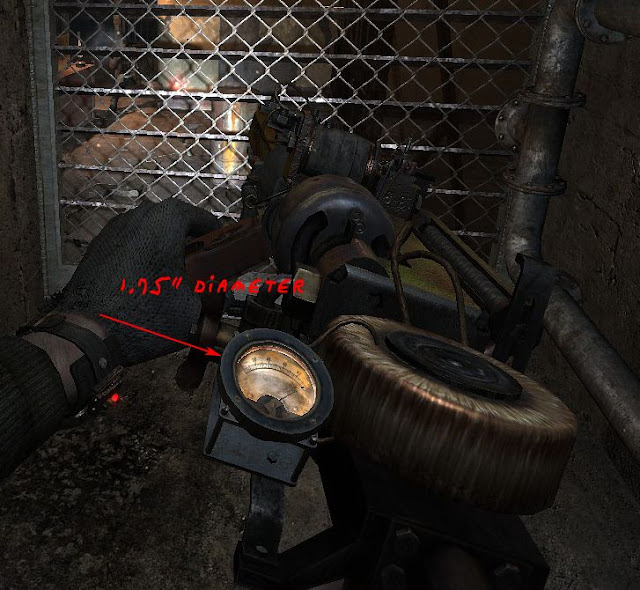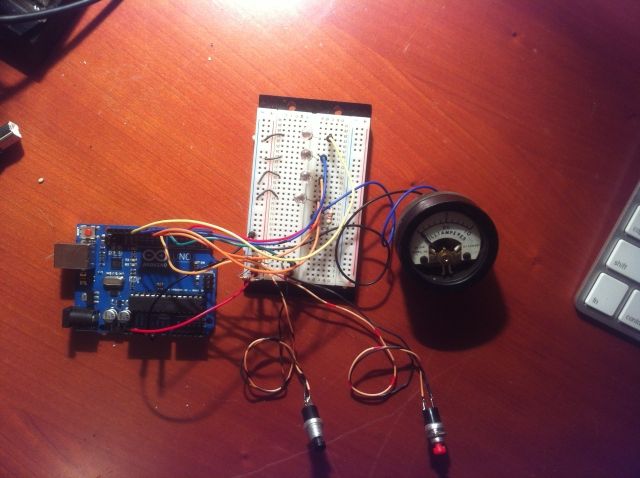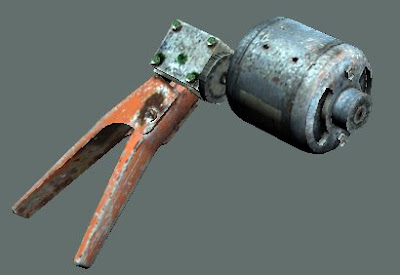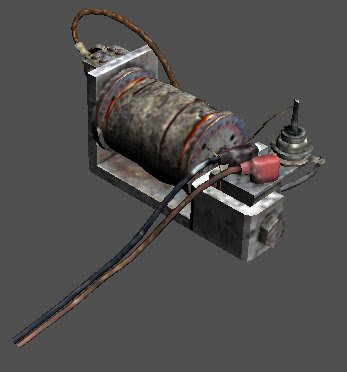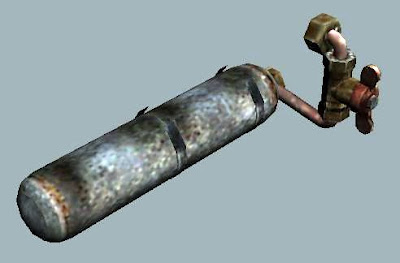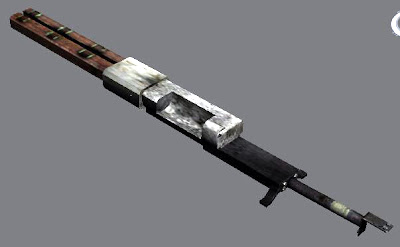holtt
Active Member
I'm working on building a reproduction of the Metro 2033 videogame Volt Driver rail gun and thought I'd spin up this thread to post my work log.
I've not seen any other builds from this game, but I personally find the game story and style quite compelling. The game takes place in the Moscow metro underground, 20 years after a nuclear war. Guns and items are manufactured from old scrap and found/salvaged materials. There is a bi of the Fallout aesthetic, minus the retro-future style.
For background on the gun, see Volt Driver - Metro Wiki - Locations, Mutants, Characters, Metro System, Achievements, and more!.
Calculating the Gun Size
The first thing I wanted to do was figure out the size of the gun. I did this two ways: by extracting the game model and calculating size based on game dimensions, and by looking at in-game screenshots.
First, here's a set of full sized drawings as extracted from the game content and exported into 3DS Max and then to PDF...
Volt Driver
Based on the game dimensions, the total length of the gun is about 44 inches. Also, when printed full scale, the ball bearings (ammo for the gun) come out to approximately 15mm in diameter, which is their specified size as specified in the game.
Second, here is a screen shot of an NPC using the gun...

Based on an estimated forearm length of 15", the gun dimensions come out at about 45 inches long.
So - total size, 44 inches long. Based on that, I've now got a full sized set of drawings printed out on an HP DesignJet.
Determining Components
Beyond basic metal and wood structure, the primary distinctive components of the Volt Driver is the integrated charging unit. It is used by the player to charge up the gun. Squeezing a handle runs a small generator, which charges up. The charge level is shown on a small analog panel meter.
I extracted the game textures for the charger, and was able to pull out this distinctive manufacturers plaque that is on the motor...
 .
.
Additional searching on the web (based on a translation of some text on the label) led me to this picture on a "for sale" site in Ukraine...

Bingo - the same motor label, but with a different serial number. It's a "Universal Motor", and used on industrial sewing machines I believe. I also think it's the same design as a Bodine Universal Motor. Here's one on eBay...
Vintage Bench Tested Bodine 1 8 HP 1 7 Amps 115 Volt AC Motor Type Sub XAL | eBay
Unfortunately the seller for the one in Ukraine wants about $70 for the motor, which is a bit steep. But more importantly, I don't think that the motor itself is the same scale in the game. I think the designers used it as a model, but reduced the size a bit for artistic purposes.
So that makes me think I should just fake one to get the scale right, and use the photo references for the real label as a guide to make my own.
Next up, the little panel meter that shows the charge of the gun. It's smaller than most panel meters, but I was able to find this one on eBay that was the right size, but also old USSR (CCCP) era, completely with Cyrillic lettering. The only downside is that the panel front is not quite the same style, with a square bezel instead of round.
[img=400x400]http://i162.photobucket.com/albums/t255/wlad2007/amper-volt/P6030018.jpg[/img]
Ordered and awaiting delivery! An important detail on this one is the lower DC milliAmp range, meaning I can drive it with an Arduino to get a full "charge" effect, complete with a drop in charge (on the meter) after every shot.
What's Next
I've been gathering bits of old weathered wood that have that darkened look of the gun's wood components. I'll need that for the main barrel plus stock and grip. It looks a lot like old fir that's been in a garage or attic for a long time. Not weathered, but definitely darkened.
I'm also making a dimensions list to find metal components needed. Like most everything in the game, things need to look very weathered and used. This wasn't something made in a factory, but from "found stuff" down in the Moscow metro tunnels and old surface factories.
The other thing is to start thinking about electronics. I'm thinking I'll make an Arduino board a core component for this. The Arduino can drive the small charge panel meter, and pumping the charger can simulate it charging up, plus pulling the trigger can simulate the charge dropping.
Additionally, I think I can put a set of blue LEDs inside the main gun barrel area, and trigger a bright blue flash along with sound FX on hitting the trigger. Ought to look nice.
Still To Find
Right now I'd love to find a bunch of old 15mm ball bearings. Specifically not new ones, but old crusty ones. I suppose I could buy new and tumble them around in some gravel and mud to weather them.
I've not seen any other builds from this game, but I personally find the game story and style quite compelling. The game takes place in the Moscow metro underground, 20 years after a nuclear war. Guns and items are manufactured from old scrap and found/salvaged materials. There is a bi of the Fallout aesthetic, minus the retro-future style.
For background on the gun, see Volt Driver - Metro Wiki - Locations, Mutants, Characters, Metro System, Achievements, and more!.
Calculating the Gun Size
The first thing I wanted to do was figure out the size of the gun. I did this two ways: by extracting the game model and calculating size based on game dimensions, and by looking at in-game screenshots.
First, here's a set of full sized drawings as extracted from the game content and exported into 3DS Max and then to PDF...
Volt Driver
Based on the game dimensions, the total length of the gun is about 44 inches. Also, when printed full scale, the ball bearings (ammo for the gun) come out to approximately 15mm in diameter, which is their specified size as specified in the game.
Second, here is a screen shot of an NPC using the gun...

Based on an estimated forearm length of 15", the gun dimensions come out at about 45 inches long.
So - total size, 44 inches long. Based on that, I've now got a full sized set of drawings printed out on an HP DesignJet.
Determining Components
Beyond basic metal and wood structure, the primary distinctive components of the Volt Driver is the integrated charging unit. It is used by the player to charge up the gun. Squeezing a handle runs a small generator, which charges up. The charge level is shown on a small analog panel meter.
I extracted the game textures for the charger, and was able to pull out this distinctive manufacturers plaque that is on the motor...

Additional searching on the web (based on a translation of some text on the label) led me to this picture on a "for sale" site in Ukraine...

Bingo - the same motor label, but with a different serial number. It's a "Universal Motor", and used on industrial sewing machines I believe. I also think it's the same design as a Bodine Universal Motor. Here's one on eBay...
Vintage Bench Tested Bodine 1 8 HP 1 7 Amps 115 Volt AC Motor Type Sub XAL | eBay
Unfortunately the seller for the one in Ukraine wants about $70 for the motor, which is a bit steep. But more importantly, I don't think that the motor itself is the same scale in the game. I think the designers used it as a model, but reduced the size a bit for artistic purposes.
So that makes me think I should just fake one to get the scale right, and use the photo references for the real label as a guide to make my own.
Next up, the little panel meter that shows the charge of the gun. It's smaller than most panel meters, but I was able to find this one on eBay that was the right size, but also old USSR (CCCP) era, completely with Cyrillic lettering. The only downside is that the panel front is not quite the same style, with a square bezel instead of round.
[img=400x400]http://i162.photobucket.com/albums/t255/wlad2007/amper-volt/P6030018.jpg[/img]
Ordered and awaiting delivery! An important detail on this one is the lower DC milliAmp range, meaning I can drive it with an Arduino to get a full "charge" effect, complete with a drop in charge (on the meter) after every shot.
What's Next
I've been gathering bits of old weathered wood that have that darkened look of the gun's wood components. I'll need that for the main barrel plus stock and grip. It looks a lot like old fir that's been in a garage or attic for a long time. Not weathered, but definitely darkened.
I'm also making a dimensions list to find metal components needed. Like most everything in the game, things need to look very weathered and used. This wasn't something made in a factory, but from "found stuff" down in the Moscow metro tunnels and old surface factories.
The other thing is to start thinking about electronics. I'm thinking I'll make an Arduino board a core component for this. The Arduino can drive the small charge panel meter, and pumping the charger can simulate it charging up, plus pulling the trigger can simulate the charge dropping.
Additionally, I think I can put a set of blue LEDs inside the main gun barrel area, and trigger a bright blue flash along with sound FX on hitting the trigger. Ought to look nice.
Still To Find
Right now I'd love to find a bunch of old 15mm ball bearings. Specifically not new ones, but old crusty ones. I suppose I could buy new and tumble them around in some gravel and mud to weather them.
Last edited:

